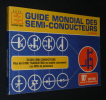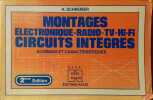-
Type
Any type (2)
Book (4250)
Disk (1)
Engraving (1)
Magazine (201)
Maps (1)
Music sheets (57)
New book (1)
Old papers (2)
Photographs (4)
Postcards (16)
-
Latest
Last 3 days (2)
Last month (17)
Last week (2)
-
Language
English (15)
French (4518)
German (1)
Italian (1)
Russian (1)
-
Century
16th (5)
17th (3)
18th (1)
19th (57)
20th (2882)
21st (705)
-
Countries
Belgium (74)
Canada (6)
China (3)
Côte d'Ivoire (1)
Denmark (4)
France (4283)
Italy (7)
Switzerland (158)
-
Syndicate
ALAC (6)
CLAQ (3)
ILAB (2982)
NVVA (49)
SLACES (49)
SLAM (2917)
SNCAO (13)
Les monts brûlés deux familles ennemies sur un sol maudit n°412 --- Film Complet du Jeudi ( parait Jeudi et Samedi)
Société parisienne d'édition 1953 in8. 1953. Agrafé. illustrations monochromes
très bon état de conservation intérieur propre
Le trésor des Caraïbes - N°418 --- Film Complet du Jeudi ( parait Jeudi et Samedi)
Société parisienne d'édition in8. Sans date. Agrafé. illustrations monochromes
Bon état voire très bon état de conservation intérieur propre
L'expédition du Fort King le feu des batailles et la flamme des coeurs n°413 --- Film Complet du Jeudi ( parait Jeudi et Samedi
Société parisienne d'édition 1953 in8. 1953. Agrafé. illustrations monochromes
très bon état de conservation intérieur propre
L'honorable Mr Sans gêne de l'insousciance... de l'amour de l'héroïsme et du drame n°410 --- Film Complet du Jeudi ( parait Jeudi et Samedi)
Société parisienne d'édition 1953 in8. 1953. Agrafé. illustrations monochromes
très bon état de conservation intérieur propre
L'orphelin de Capri n°417 --- Film Complet du Jeudi ( parait Jeudi et Samedi)
Société parisienne d'édition 1953 in8. 1953. Agrafé. illustrations monochromes
très bon état de conservation intérieur propre
L'étoile du destin n°406 --- Film Complet du Jeudi ( parait Jeudi et Samedi)
Société parisienne d'édition 1953 in8. 1953. Agrafé. illustrations monochromes
très bon état de conservation intérieur propre
Reviens petite Sheba n°405 --- Film Complet du Jeudi ( parait Jeudi et Samedi)
Société parisienne d'édition 1953 in8. 1953. Agrafé. illustrations monochromes
très bon état de conservation intérieur propre
Rue de l'estrapade n°415 --- Film Complet du Jeudi ( parait Jeudi et Samedi)
Société parisienne d'édition 1953 in8. 1953. Agrafé. illustrations monochromes
très bon état de conservation intérieur propre
Salomé (ou l'amour s'oppose à la haine) n°403 --- Film Complet du Jeudi ( parait Jeudi et Samedi)
Société parisienne d'édition 1953 in8. 1953. Agrafé. illustrations monochromes
très bon état de conservation intérieur propre
Une fille a disparu (Le puits) n°409 --- Film Complet du Jeudi ( parait Jeudi et Samedi)
Société parisienne d'édition 1953 in8. 1953. Agrafé. illustrations monochromes
très bon état de conservation intérieur propre
Valse Céleste n°392 --- Film Complet du Jeudi ( parait Jeudi et Samedi)
Société parisienne d'édition 1953 in8. 1953. Agrafé. illustrations monochromes
très bon état de conservation intérieur propre
Etude de l'étage amplificateur à résistances.
Paris, Dunod, 1947. 16 x 24, 124 pp., 67 figures, broché, bon état.
préface de E. Fromy.
CULTURE TELE
Hors Collection. 1995. In-8. Broché. Bon état, Couv. convenable, Dos satisfaisant, Intérieur frais. 120 pages. Ouvrage à spirales métal.. . . . Classification Dewey : 791.45-Télévision
Livre jeu. EN 500 questions pour tester vos connaissances. Classification Dewey : 791.45-Télévision
"L'AVENIR DE LA TELEVISION : COULEUR ET PUBLICITE / COLLECTION ""BIBLIOTHEQUE DES ATTACHES DE PRESSE"" N°4."
COMTE AUGUSTE. 1967. In-12. Broché. Etat d'usage, Couv. défraîchie, Dos satisfaisant, Intérieur frais. 183 pages.. . . . Classification Dewey : 791.45-Télévision
Classification Dewey : 791.45-Télévision
ARRETS SUR IMAGES.
FAYARD.. 1994.. In-8. Broché. Bon état, Couv. convenable, Dos satisfaisant, Intérieur frais. 234 pages. 1ère de couverture illustrée en noir et blanc.. . . . Classification Dewey : 791.45-Télévision
Illustré par Sempé. Classification Dewey : 791.45-Télévision
ARRETS SUR IMAGES
Fayard. 1994. In-8. Broché. Bon état, Couv. convenable, Dos satisfaisant, Intérieur frais. 234 pages.. . . . Classification Dewey : 791.45-Télévision
Couverture de Sempé. Le professeur et la réincarnée. Jean-Pierre Coffe contre la Cellophane. Milosevic = Hitler... Classification Dewey : 791.45-Télévision
OU SONT LES CAMERAS? TRAITE DE LA GLOIRE MEDIATIQUE.
BELFOND.. 1989.. In-8. Broché. Bon état, Couv. convenable, Dos satisfaisant, Intérieur frais. 255 pages.. . . . Classification Dewey : 791.45-Télévision
Classification Dewey : 791.45-Télévision
Où sont les caméras? Traité de la gloire médiatique.
Couverture souple. Broché. 260 pages.
Livre. Editions Belfond, 1989.
Geschlechtsspezifisches Gesprächsverhalten. Höraktivitäten und Unterbrechungen in Radiogesprächsrunden. Diss.
Pfaffenweiler, Centaurus-Verlagsgesellschaft 1997, 210x150mm, 181Seiten, broschiert. Schönes Exemplar.
Pour un paiement via PayPal, veuillez nous en faire la demande et nous vous enverrons une facture PayPal
Amplification et commutation. Relevé, interprétation et utilisation des caractéristiques des composants discrets et intégrés.
1973 Paris, Editions Radio, 1973, in 8° broché, 368 pages ; nombreuses figures ; couverture illustrée.
...................... Photos sur demande ..........................


Phone number : 04 77 32 63 69
Guide mondial des semi-conducteurs
Editions radio Dos carré collé 1983 In-8 (22,7 x 15,5 cm), dos carré collé, 220 pages ; mors légèrement frottés, papier bruni, bon état. Livraison a domicile (La Poste) ou en Mondial Relay sur simple demande.
Montages électroniques - Radio - TV - HiFi - circuits intégrés. Schémas et caractéristiques.
Couverture souple. Broché. 128 pages. Défraîchi. Couverture légèrement abîmée. Légères rousseurs.
Livre. 2e édition. Editions Radio, 1981.
Techniques et applications des transistors - propriétés, fonctionnement, Technologie, contrôle, mesure d'utilisation des transistors comme amplificateurs B.F., H.F. & de puissance & en électronique
PARIS, Sté des Ed. Radio - 1959 - In-8 - broché - couverture illustrée - 225 figures + 3 en texte -238 pages - correct
- Livraison a domicile (La Poste) ou sur simple demande en Mondial Relay.- ATTENTION: Colis recommandé uniquement sur demande (parcel recommended on request). Si vous désirez un remboursement équivalent au montant de votre achat, en cas de perte détérioration ou spoliation, demandez-nous expressément un envoi en recommandé ( if you wish a repayment equivalent to the amount of your purchase, in case of loss - deterioration or despoliation, ask us expressly for a sending recommended)- Conditions de vente : Les frais de port sont affichés à titre Indicatifs (pour un livre) Nous pouvons être amené à vous contacter pour vous signaler le surcoût du au nopmbre de livres achetés ou du poids de ceux-ci. - Conditions of sale : The shipping costs are displayed as an indication (for one book) We may need to contact you to inform you of the cost of the additional shipping depending on the weight and the number of books- Possibilité d'envoi par Mondial-Relay - Réception en boutique sur rendez-vous. Librairie G. PORCHEROT - SP.Rance - 0681233148
LE BALE - LA TELEVISION AU PLURIEL - DE A A Z TOUTES LES REPONSES A VOS QUESTIONS
ENTREPRISE MODERNE D'EDITION. 1986. In-8. Broché. Etat d'usage, Couv. légèrement passée, Dos satisfaisant, Papier jauni. 341 pages augmentées de nombreuses illustrations en noir et blanc dans et hors texte.. . . . Classification Dewey : 791.45-Télévision
Classification Dewey : 791.45-Télévision
 Write to the booksellers
Write to the booksellers










































